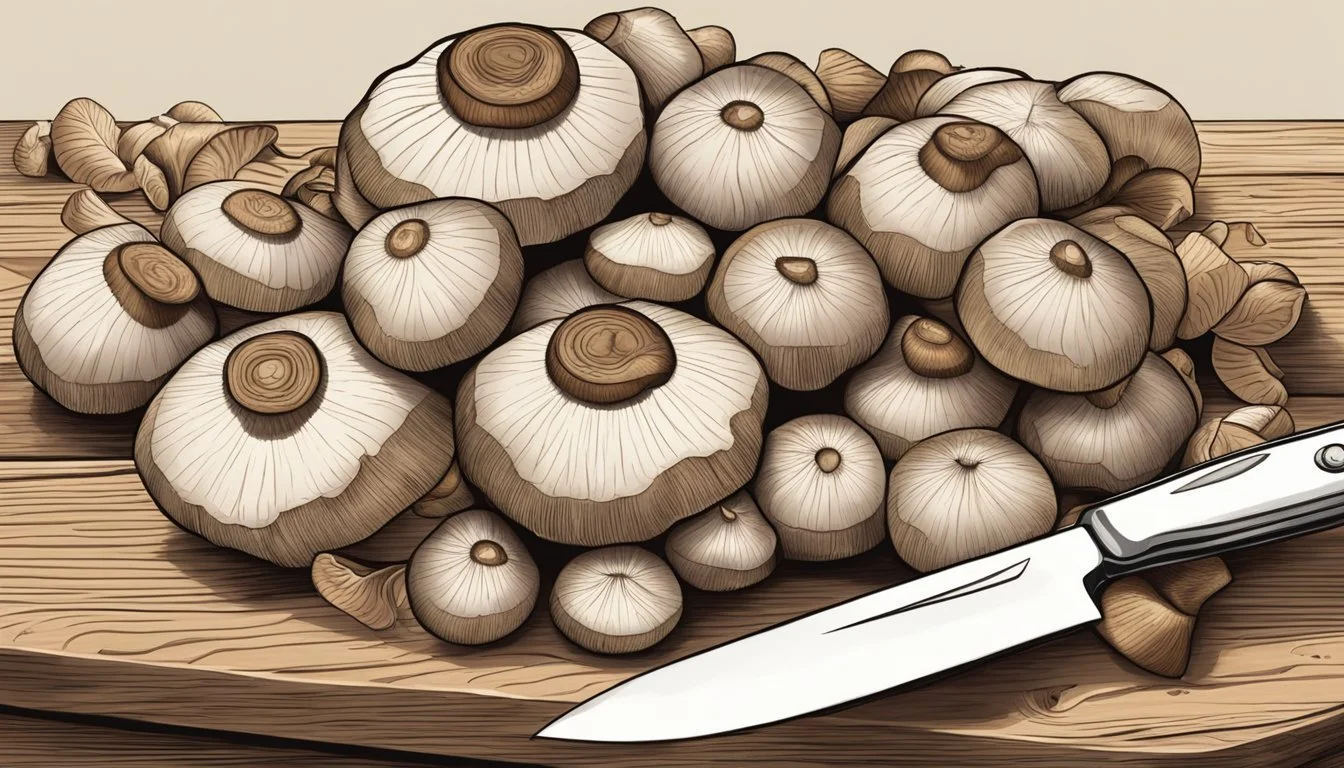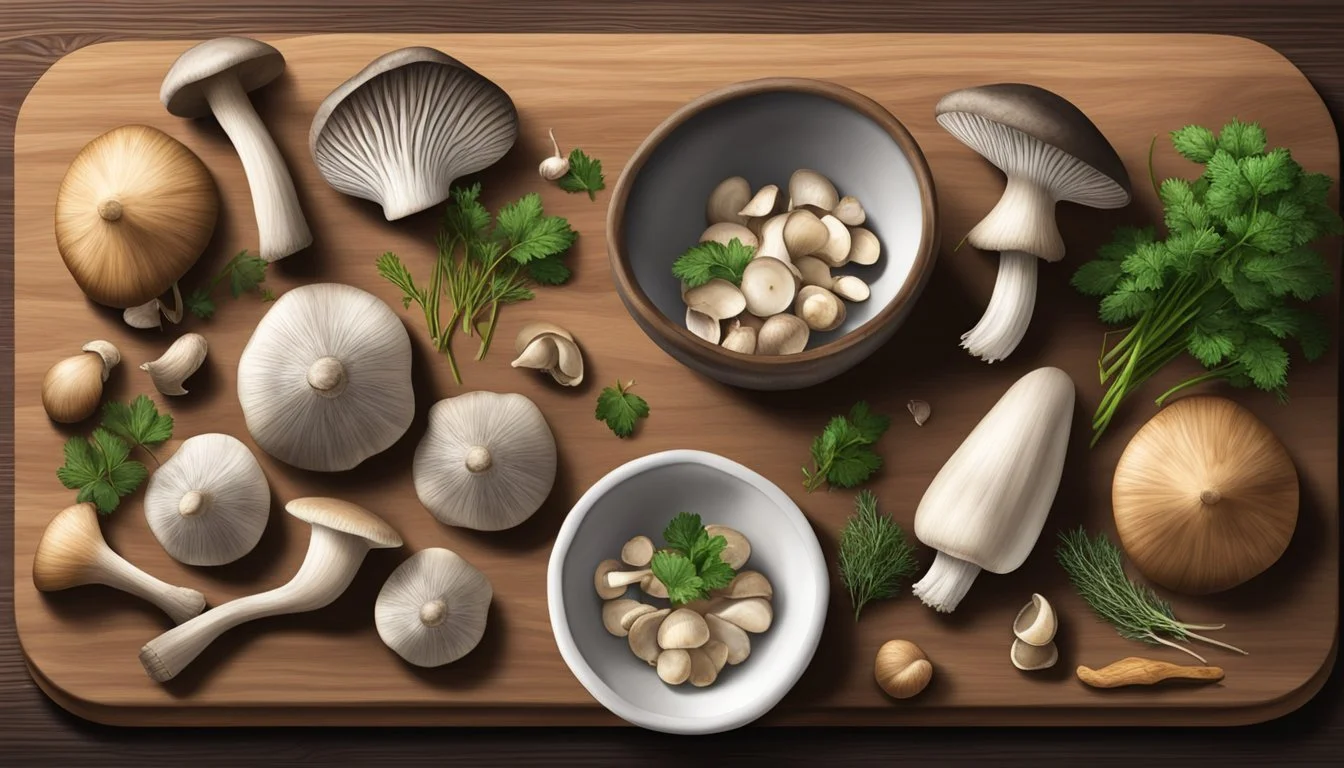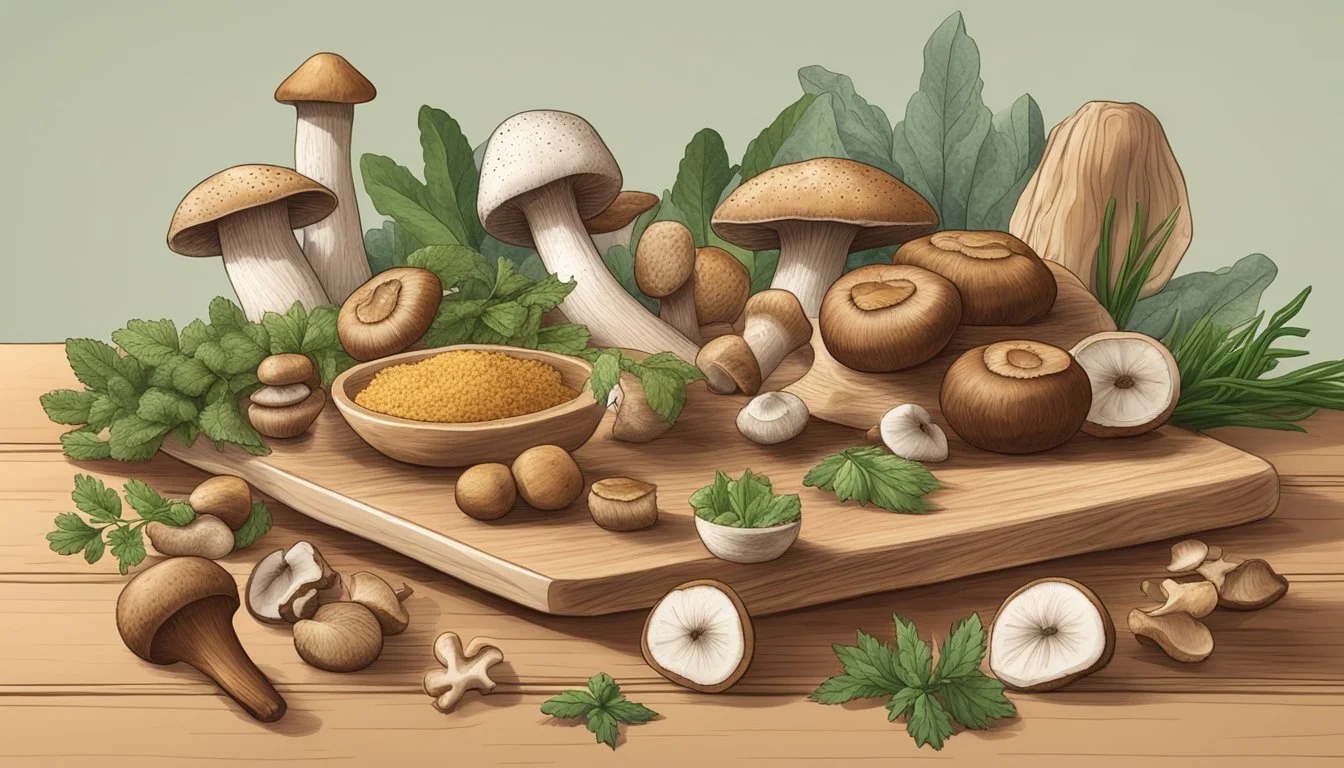Shiitake Mushrooms Substitutes
Top Alternatives for Any Recipe
Finding the right substitute for shiitake mushrooms can make a significant difference in your dish, especially when you need to replicate that distinct umami flavor and meaty texture. Portobello mushrooms are an excellent substitute, providing a similar earthy taste and robust texture. These mushrooms are widely available and work well in soups, stews, and stir-fries, making them a versatile choice in various recipes.
Another great option is Cremini mushrooms. Cremini, often referred to as baby bella mushrooms, offer a similar size and flavor profile to shiitakes, which can help maintain the integrity of your dish. They bring a slightly milder taste compared to portobellos but are still rich in umami, making them suitable for a wide range of applications from sautés to casseroles.
For those looking for a more delicate and mildly flavored alternative, Enoki mushrooms can be used. These mushrooms have a tender texture and can add a unique flavor dimension to your dishes, though they do not offer the same meaty bite as shiitakes. Nonetheless, they can be a great addition for those times when you need to keep the focus on the flavors of other ingredients while still enjoying the benefits of mushrooms.
Understanding Shiitake Mushrooms
Shiitake mushrooms, native to East Asia, are beloved for their earthy flavor, meaty texture, and rich nutritional profile. They are available in fresh and dried forms, each with unique characteristics and uses.
Characteristics and Culinary Uses
Shiitake mushrooms have an umami flavor with a meaty texture. Native to Japan and China, these mushrooms are widely used in various cuisines for their depth of flavor. They are often found in soups, stir-fries, and stews. The versatility of shiitake mushrooms makes them ideal for both vegetarian and non-vegetarian dishes.
Fresh shiitake mushrooms are plump and have a strong, woody taste. Dried shiitake mushrooms have an intensified flavor and are usually soaked in water before use, which rehydrates them and releases their deep, earthy aroma. This process makes them perfect for broths and sauces.
Health Benefits
Shiitake mushrooms are packed with nutrients. They are rich in B vitamins like B2 and B3, which aid in energy production. They also contain minerals such as selenium, copper, and zinc. Being high in fiber, shiitake mushrooms help with digestion.
A notable feature is their antioxidant content, which supports the immune system. Shiitake mushrooms also contain compounds believed to have anti-inflammatory and anticancer properties, contributing to general wellness. Their nutritional profile makes them beneficial for skin health, heart health, and overall immune function.
Fresh Versus Dried Shiitake
Fresh and dried shiitake mushrooms vary in texture and flavor. Fresh shiitakes are juicy with a robust taste, suitable for quick-cooking methods like sautéing. They are more perishable and should be used soon after purchase.
Dried shiitake mushrooms have a concentrated, powerful flavor. Rehydrating them in warm water brings back their texture and releases more aroma. The soaking water itself can be used as a flavorful broth in recipes. Dried shiitakes are convenient to store for extended periods, making them versatile pantry items.
Shiitake mushrooms, in both forms, offer an abundance of culinary possibilities and health advantages, making them a staple in many kitchens.
Popular Shiitake Mushroom Substitutes
When a recipe calls for shiitake mushrooms but they are unavailable, other mushrooms can serve as excellent replacements. The following options are notable for their unique flavors and textures, making them suitable for a variety of culinary applications from soups to stews to grilled dishes.
Portobello Mushrooms
Portobello mushrooms are a great substitute for shiitake mushrooms due to their robust flavor and thick, meaty texture. These mushrooms are particularly popular for grilling and can be used in various dishes including sauces and stews. Portobellos are mature cremini mushrooms and bring a rich, almost beefy flavor to recipes.
Texture & Flavor: The texture is dense and substantial, making them a satisfying meat substitute in vegetarian dishes. Their flavor becomes more pronounced when cooked, especially when grilled or roasted.
Usage: They can be sliced or diced and used in soups, stews, and sauces. Additionally, their large cap makes them ideal for stuffing or using as a base for grilled dishes.
Oyster Mushrooms
Oyster mushrooms are another excellent shiitake mushroom substitute, known for their delicate and mildly sweet flavor. These mushrooms are also prized for their unique texture, which is more tender and less chewy compared to shiitake mushrooms.
Texture & Flavor: Oyster mushrooms have a softer texture that can add a subtle nuance to dishes. Their flavor is more delicate, making them suitable for recipes that benefit from a lighter touch.
Usage: Ideal for soups and stir-fries, oyster mushrooms can also be sautéed or added to stews. They absorb spices and sauces well, enhancing the overall flavor of the dish.
Porcini Mushrooms
Porcini mushrooms offer an earthy flavor that can be a compelling alternative to shiitake mushrooms. Available in both dried and fresh forms, porcini mushrooms are commonly used in Italian and French cuisines, especially in dishes like risotto.
Texture & Flavor: The texture of porcini mushrooms is slightly firm, and they hold up well during cooking. Their deep, earthy flavor can add a rich dimension to many recipes, making them a versatile option.
Usage: Dried porcini mushrooms are often rehydrated before use, making them perfect for sauces, soups, and stews. Fresh porcini mushrooms can also be sautéed, grilled, or incorporated into risottos and other hearty dishes.
Alternative Substitutes for Shiitake Mushrooms
When shiitake mushrooms are unavailable, several alternatives can provide similar flavors and textures. The choices include cremini and button mushrooms, maitake and king oyster mushrooms, and enoki and lobster mushrooms, each bringing unique qualities to various dishes.
Cremini and Button Mushrooms
Cremini mushrooms, also known as baby bellas, offer a similar earthiness and slightly meaty texture akin to shiitake mushrooms. They are small, brown, and have a more pronounced flavor than their white counterpart, the button mushroom.
Button mushrooms, though milder in taste, are widely accessible and can still provide a satisfactory texture in dishes like soups and sauces. Both varieties can be easily sautéed, stir-fried, or added to pizzas and casseroles. Their versatility makes them a reliable choice when aiming for that umami flavor profile.
Maitake and King Oyster Mushrooms
Maitake mushrooms, also known as "hen-of-the-woods," provide a rich umami taste and a firm texture comparable to shiitake mushrooms. They can be used in stir-fries, soups, and even as a roasted side dish.
On the other hand, king oyster mushrooms have a robust, chewy texture that holds up well in various cooking methods. Their delicate flavor allows them to absorb the seasoning wonderfully, making them ideal for grilling or braising. Both maitake and king oyster mushrooms are excellent for dishes needing that deep, satisfying umami note.
Enoki and Lobster Mushrooms
Enoki mushrooms bring a delicate crunch and subtle flavor, making them ideal for salads, soups, and as a garnish. Their long, thin stems and small caps provide a unique texture contrast, although they lack the meaty quality of shiitake mushrooms.
Lobster mushrooms are another distinct alternative, known for their vibrant color and firm, dense texture. They offer a mild seafood-like flavor, adding a different yet delightful twist to dishes like stir-fries and soups. These mushrooms can be a standout ingredient in various culinary applications, providing both visual appeal and taste.
Non-Mushroom Alternatives
For those seeking non-mushroom substitutes for shiitake mushrooms, a variety of options offer diverse textures and flavors. These alternatives range from protein-packed tofu and tempeh to plant-based choices and the robust taste of sun-dried tomatoes.
Tofu and Tempeh as Meat Substitutes
Tofu and tempeh are excellent non-mushroom options to replace shiitake mushrooms in various recipes. Both provide a meaty texture and are high in protein, making them suitable for soups, sauces, and stir-fries.
Tofu is versatile and absorbs flavors well. It can be used in dishes that require a softer texture.
Tempeh offers a firmer texture and a nutty flavor, adding more depth to dishes. It is particularly good for recipes that benefit from a more substantial ingredient. Both tofu and tempeh are also low in calories, making them a healthy alternative.
Plant-Based Options
Plant-based substitutes such as eggplant and zucchini can replace shiitake mushrooms effectively, especially in savory dishes.
Eggplant has a firm texture and can absorb flavors from sauces and spices, making it a great addition to pasta and stir-fries. When cooked, it can attain a similar mouthfeel to mushrooms.
Zucchini is another versatile option with a milder flavor and a slightly crunchy texture when cooked. It can be used in soups, stews, and sautés. Both eggplant and zucchini are low in calories and can add bulk and nutrients to any recipe.
Sun-Dried Tomatoes
Sun-dried tomatoes are a unique substitute for shiitake mushrooms, providing an intense umami flavor that can enhance many dishes.
These tomatoes are packed with a concentrated flavor that can add depth to pasta sauces, soups, and salads. They are chewy and robust, making them a great textural component in various recipes.
When using sun-dried tomatoes, consider their strong taste and reduce additional seasoning accordingly. They offer both flavor complexity and nutritional benefits, like being rich in antioxidants and vitamins.
Overall, these non-mushroom substitutes can provide similar benefits and enhance your dishes with their own unique qualities.
Culinary Tips and Tricks
When replacing shiitake mushrooms, the preparation methods and dish enhancements play pivotal roles in achieving the desired flavor and texture.
Preparing Mushroom Substitutes
Selecting the right mushroom substitute isn't just about replacing one ingredient with another. Portobello and oyster mushrooms are excellent for replicating a meaty texture. Cremini mushrooms can be used to mirror the earthy flavor of shiitake mushrooms. For dried substitutes, remember to reconstitute them in water prior to usage. This helps achieve a closer texture match.
Porcini mushrooms work wonderfully in soups and broths due to their strong, aromatic flavors. Use mushroom powder to intensify the flavor profile without altering the texture significantly. For grilling or roasting, brush mushrooms with a light coating of oil to enhance their natural flavors and prevent drying out.
Enhancing Dishes with Substitutes
Certain substitutes can elevate a dish's flavor profile. Dried shiitake mushrooms offer a concentrated, smoky flavor when reconstituted. Use about one-fourth the amount in dried form. Tempeh provides a hearty alternative with added nutritional benefits. Incorporate it in sauces for a firmer texture.
Adding maitake mushrooms to brown sauces can enrich the sauce with a deeper umami flavor. Tofu and sundried tomatoes offer versatile options, fitting well in various dishes while providing unique textures. For soups and broths, maintain balance by combining button mushrooms for texture and mushroom powder for flavor.
Shopping and Storage
When shopping for substitutes for shiitake mushrooms, look for quality and availability at grocery stores and supermarkets. Proper storage, whether in the fridge or pantry, can prolong the shelf life of both fresh and dried alternatives.
Selecting the Best Substitutes
Selecting the best substitutes for shiitake mushrooms depends on the intended use in recipes. Portobello and oyster mushrooms are excellent for meat-based dishes. Porcini mushrooms, which grow around hardwood trees, offer a robust flavor for soups and broths.
Fresh substitutes should be free from spots and have firm textures. Dried alternatives, such as dried shiitake or porcini, should be free of moisture and have a strong aroma. Grocery stores often stock these varieties in both fresh and dried forms, depending on the season.
Storing Mushrooms and Their Substitutes
Fresh mushrooms, whether cremini, maitake, or oyster, should be stored in the fridge. Use a paper bag to absorb excess moisture and keep them dry. This method ensures they stay fresh for up to a week.
Dried substitutes such as dried shiitake or porcini mushrooms require storage in a cool, dark pantry. An airtight container is best to keep away moisture and pests. Properly stored, dried mushrooms can last several months to a year. Keeping the storage conditions optimal helps maintain their quality and flavor for longer periods.






